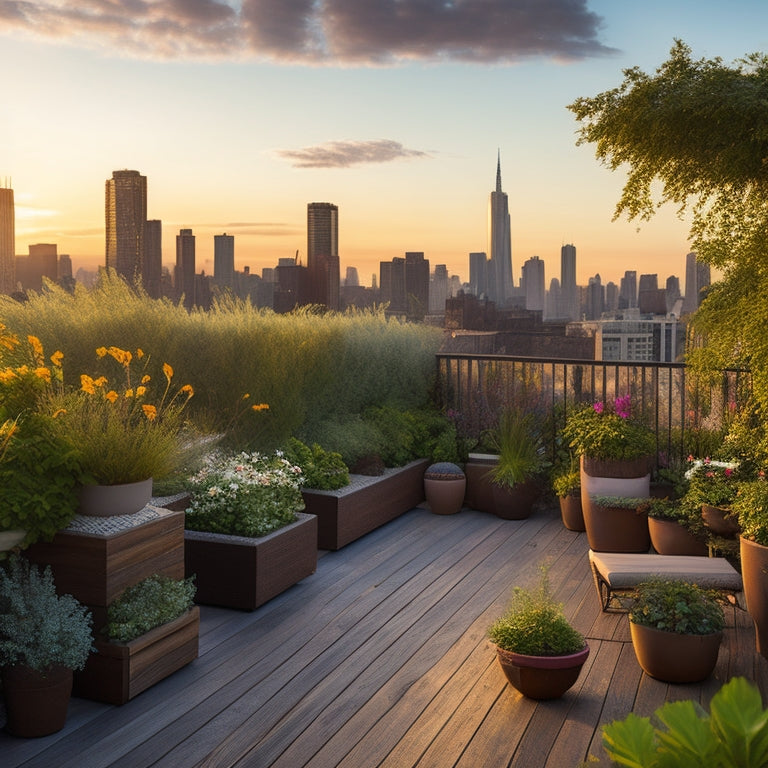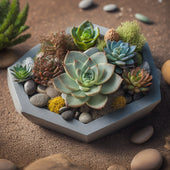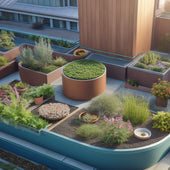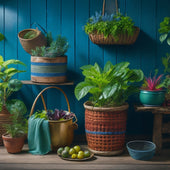
3 Best Rooftop Gardening Ideas for Apartment Dwellers
Share
You can turn your rooftop into a thriving garden by focusing on three essential strategies. Maximize your space by using trellises, arbors, and wall-mounted planters to grow vining plants like peas and cucumbers. Choose durable, weather-resistant containers with proper drainage and consider the mature size of your plants when selecting a container. Also, take into account the microclimates and shading on your rooftop, adjusting plant placement based on sun exposure, wind direction, and natural windbreaks. By implementing these ideas, you'll be well on your way to creating a vibrant rooftop oasis that's tailored to your unique space and style, and there's even more to discover.
Key Takeaways
• Maximize vertical growing space with vining plants, trellises, and wall gardens to optimize limited rooftop area.
• Choose durable, weather-resistant containers with proper drainage and sufficient size for mature plants and rooftop space.
• Identify microclimates and shading on the rooftop, adjusting plant placement according to sun exposure, wind protection, and natural windbreaks.
• Utilize hanging baskets and wall-mounted planters to create lush environments without sacrificing floor space.
• Incorporate living walls or green screens to enhance visual appeal, insulation, and air purification in the rooftop garden.
Maximizing Vertical Growing Space
By training vining plants like peas, cucumbers, or tomatoes to climb up trellises or arbors, you can efficiently utilize the limited space on your rooftop garden, making the most of your vertical growing area.
This technique allows you to grow more plants in a smaller footprint, perfect for apartment dwellers with compact rooftop gardens.
Vertical planters and wall gardens are also excellent options for maximizing vertical space.
These space-saving solutions enable you to grow a variety of plants, from herbs to flowers, on walls, fences, or trellises.
By using wall-mounted planters or hanging baskets, you can create a lush, verdant atmosphere without sacrificing precious floor space.
Additionally, consider incorporating a living wall or green screen into your rooftop garden design.
These innovative features not only add visual interest but also provide insulation and help purify the air.
Choosing the Right Containers
Select containers that are specifically designed for rooftop gardening, taking into account factors such as material, size, drainage, and weight capacity to guarantee your plants thrive in their new home. You want to make certain your containers can withstand the harsh rooftop conditions, such as intense sunlight, strong winds, and extreme temperatures.
When choosing the right containers, consider the following key factors:
-
Material: Look for durable, weather-resistant materials like fiberglass, polypropylene, or ceramic. Avoid materials that can degrade quickly, like wood or plastic.
-
Drainage: Make sure your containers have proper drainage holes to prevent waterlogged soil and root rot.
-
Size: Select containers that fit your rooftop space and accommodate the mature size of your plants.
-
Weight capacity: Choose containers that can support the weight of the soil, plants, and water.
-
Aesthetics: Pick containers that fit your personal style and complement your rooftop garden's design.
Utilizing Microclimates and Shading
As you've carefully chosen the right containers for your rooftop garden, now it's time to contemplate the unique microclimates and shading opportunities that exist on your rooftop, which can greatly impact the health and success of your plants.
Take note of the areas that receive full sun exposure, partial shade, or dappled light, as each plant has its own specific requirements.
Consider the direction your rooftop faces and how it affects the sun's path throughout the day. You may need to adjust your plant placement accordingly.
Wind protection is also essential, as strong gusts can damage or destroy your plants.
Look for areas that provide natural windbreaks, such as near parapet walls or behind rooftop structures. Alternatively, you can create your own wind protection using trellises, screens, or windbreak nets.
Frequently Asked Questions
How Do I Prevent Water From Leaking Onto My Downstairs Neighbors?
You'll want to prevent water from leaking onto your downstairs neighbors by applying waterproofing techniques, such as sealing joints and using a waterproof membrane, and implementing effective drainage solutions, like a sloping roof and gutter system.
Can I Grow a Rooftop Garden in a Windy or High-Rise Location?
You'll thrive in windy or high-rise locations by choosing wind-resistant plants and incorporating a thoughtful rooftop garden design, ensuring stability and structure to protect your haven from harsh gusts and turbulence.
Are There Any Rooftop Gardening Rules or Regulations I Should Know?
You're one of the 75% of urban residents craving green spaces! Before you start, you'll need to secure rooftop gardening permits and guarantee your design adheres to structural weight limits, avoiding costly renovations or even evictions.
How Do I Keep Pests Like Mosquitoes and Rodents Out of My Garden?
You'll want to shield your rooftop oasis from unwanted critters by incorporating natural repellents like citronella or lemongrass into your garden design, and setting up pest traps like sticky tapes or UV-light traps to catch unwanted visitors.
Can I Use a Rooftop Garden for Entertainment and Outdoor Living?
"As you envision your rooftop oasis, imagine hosting rooftop gatherings under the stars, surrounded by lush greenery and comfortable outdoor furniture, creating a sense of community and belonging, where memories are made and friendships are forged."
Related Posts
-

Why Succulents Thrive in DIY Concrete Planters
You've likely noticed that succulents seem to flourish in DIY concrete planters, and it's not just a coincidence - th...
-

Why Succulents Thrive in DIY Concrete Planters
You've likely noticed that succulents seem to flourish in DIY concrete planters, and it's not just a coincidence - th...
-

Why Succulents Thrive in DIY Concrete Planters
You've likely noticed that succulents seem to flourish in DIY concrete planters, and it's not just a coincidence - th...
-

Why Succulents Thrive in DIY Concrete Planters
You've likely noticed that succulents seem to flourish in DIY concrete planters, and it's not just a coincidence - th...
-

Why Succulents Thrive in DIY Concrete Planters
You've likely noticed that succulents seem to flourish in DIY concrete planters, and it's not just a coincidence - th...
-

Why Succulents Thrive in DIY Concrete Planters
You've likely noticed that succulents seem to flourish in DIY concrete planters, and it's not just a coincidence - th...
-

Why Succulents Thrive in DIY Concrete Planters
You've likely noticed that succulents seem to flourish in DIY concrete planters, and it's not just a coincidence - th...
-

Why Succulents Thrive in DIY Concrete Planters
You've likely noticed that succulents seem to flourish in DIY concrete planters, and it's not just a coincidence - th...
-

Why Succulents Thrive in DIY Concrete Planters
You've likely noticed that succulents seem to flourish in DIY concrete planters, and it's not just a coincidence - th...
-

Why Succulents Thrive in DIY Concrete Planters
You've likely noticed that succulents seem to flourish in DIY concrete planters, and it's not just a coincidence - th...
-

Why Succulents Thrive in DIY Concrete Planters
You've likely noticed that succulents seem to flourish in DIY concrete planters, and it's not just a coincidence - th...
-

Why Succulents Thrive in DIY Concrete Planters
You've likely noticed that succulents seem to flourish in DIY concrete planters, and it's not just a coincidence - th...
-

Why Succulents Thrive in DIY Concrete Planters
You've likely noticed that succulents seem to flourish in DIY concrete planters, and it's not just a coincidence - th...
-

Why Succulents Thrive in DIY Concrete Planters
You've likely noticed that succulents seem to flourish in DIY concrete planters, and it's not just a coincidence - th...
-

Why Succulents Thrive in DIY Concrete Planters
You've likely noticed that succulents seem to flourish in DIY concrete planters, and it's not just a coincidence - th...
-

Why Succulents Thrive in DIY Concrete Planters
You've likely noticed that succulents seem to flourish in DIY concrete planters, and it's not just a coincidence - th...
-

Why Succulents Thrive in DIY Concrete Planters
You've likely noticed that succulents seem to flourish in DIY concrete planters, and it's not just a coincidence - th...
-

3 Best Roof Garden Drainage Solutions for Planters
When designing your roof garden, you'll want to implement a planter drainage system that guarantees water flows freel...
-

3 Best Roof Garden Drainage Solutions for Planters
When designing your roof garden, you'll want to implement a planter drainage system that guarantees water flows freel...
-

3 Best Roof Garden Drainage Solutions for Planters
When designing your roof garden, you'll want to implement a planter drainage system that guarantees water flows freel...
-

3 Best Roof Garden Drainage Solutions for Planters
When designing your roof garden, you'll want to implement a planter drainage system that guarantees water flows freel...
-

3 Best Roof Garden Drainage Solutions for Planters
When designing your roof garden, you'll want to implement a planter drainage system that guarantees water flows freel...
-

3 Best Roof Garden Drainage Solutions for Planters
When designing your roof garden, you'll want to implement a planter drainage system that guarantees water flows freel...
-

3 Best Roof Garden Drainage Solutions for Planters
When designing your roof garden, you'll want to implement a planter drainage system that guarantees water flows freel...
-

3 Best Roof Garden Drainage Solutions for Planters
When designing your roof garden, you'll want to implement a planter drainage system that guarantees water flows freel...
-

3 Best Roof Garden Drainage Solutions for Planters
When designing your roof garden, you'll want to implement a planter drainage system that guarantees water flows freel...
-

3 Best Roof Garden Drainage Solutions for Planters
When designing your roof garden, you'll want to implement a planter drainage system that guarantees water flows freel...
-

3 Best Roof Garden Drainage Solutions for Planters
When designing your roof garden, you'll want to implement a planter drainage system that guarantees water flows freel...
-

3 Best Roof Garden Drainage Solutions for Planters
When designing your roof garden, you'll want to implement a planter drainage system that guarantees water flows freel...
-

3 Best Roof Garden Drainage Solutions for Planters
When designing your roof garden, you'll want to implement a planter drainage system that guarantees water flows freel...
-

7 Creative Upcycled Planter Tutorials to Try Now
Get ready to transform your outdoor space with these 7 creative upcycled planter tutorials! Start by turning cinder b...
-

7 Creative Upcycled Planter Tutorials to Try Now
Get ready to transform your outdoor space with these 7 creative upcycled planter tutorials! Start by turning cinder b...
-

7 Creative Upcycled Planter Tutorials to Try Now
Get ready to transform your outdoor space with these 7 creative upcycled planter tutorials! Start by turning cinder b...
-

7 Creative Upcycled Planter Tutorials to Try Now
Get ready to transform your outdoor space with these 7 creative upcycled planter tutorials! Start by turning cinder b...
-

7 Creative Upcycled Planter Tutorials to Try Now
Get ready to transform your outdoor space with these 7 creative upcycled planter tutorials! Start by turning cinder b...
-

7 Creative Upcycled Planter Tutorials to Try Now
Get ready to transform your outdoor space with these 7 creative upcycled planter tutorials! Start by turning cinder b...
-

7 Creative Upcycled Planter Tutorials to Try Now
Get ready to transform your outdoor space with these 7 creative upcycled planter tutorials! Start by turning cinder b...
-

7 Creative Upcycled Planter Tutorials to Try Now
Get ready to transform your outdoor space with these 7 creative upcycled planter tutorials! Start by turning cinder b...
-

7 Creative Upcycled Planter Tutorials to Try Now
Get ready to transform your outdoor space with these 7 creative upcycled planter tutorials! Start by turning cinder b...
-

7 Creative Upcycled Planter Tutorials to Try Now
Get ready to transform your outdoor space with these 7 creative upcycled planter tutorials! Start by turning cinder b...
-

7 Creative Upcycled Planter Tutorials to Try Now
Get ready to transform your outdoor space with these 7 creative upcycled planter tutorials! Start by turning cinder b...
-

7 Creative Upcycled Planter Tutorials to Try Now
Get ready to transform your outdoor space with these 7 creative upcycled planter tutorials! Start by turning cinder b...
-

7 Creative Upcycled Planter Tutorials to Try Now
Get ready to transform your outdoor space with these 7 creative upcycled planter tutorials! Start by turning cinder b...
-

7 Creative Upcycled Planter Tutorials to Try Now
Get ready to transform your outdoor space with these 7 creative upcycled planter tutorials! Start by turning cinder b...
-

7 Creative Upcycled Planter Tutorials to Try Now
Get ready to transform your outdoor space with these 7 creative upcycled planter tutorials! Start by turning cinder b...
-

7 Creative Upcycled Planter Tutorials to Try Now
Get ready to transform your outdoor space with these 7 creative upcycled planter tutorials! Start by turning cinder b...
-

7 Creative Upcycled Planter Tutorials to Try Now
Get ready to transform your outdoor space with these 7 creative upcycled planter tutorials! Start by turning cinder b...
-

7 Creative Upcycled Planter Tutorials to Try Now
Get ready to transform your outdoor space with these 7 creative upcycled planter tutorials! Start by turning cinder b...
-

7 Creative Upcycled Planter Tutorials to Try Now
Get ready to transform your outdoor space with these 7 creative upcycled planter tutorials! Start by turning cinder b...
-

7 Creative Upcycled Planter Tutorials to Try Now
Get ready to transform your outdoor space with these 7 creative upcycled planter tutorials! Start by turning cinder b...
-

7 Creative Upcycled Planter Tutorials to Try Now
Get ready to transform your outdoor space with these 7 creative upcycled planter tutorials! Start by turning cinder b...
-

7 Creative Upcycled Planter Tutorials to Try Now
Get ready to transform your outdoor space with these 7 creative upcycled planter tutorials! Start by turning cinder b...
-

7 Creative Upcycled Planter Tutorials to Try Now
Get ready to transform your outdoor space with these 7 creative upcycled planter tutorials! Start by turning cinder b...
-

7 Creative Upcycled Planter Tutorials to Try Now
Get ready to transform your outdoor space with these 7 creative upcycled planter tutorials! Start by turning cinder b...


